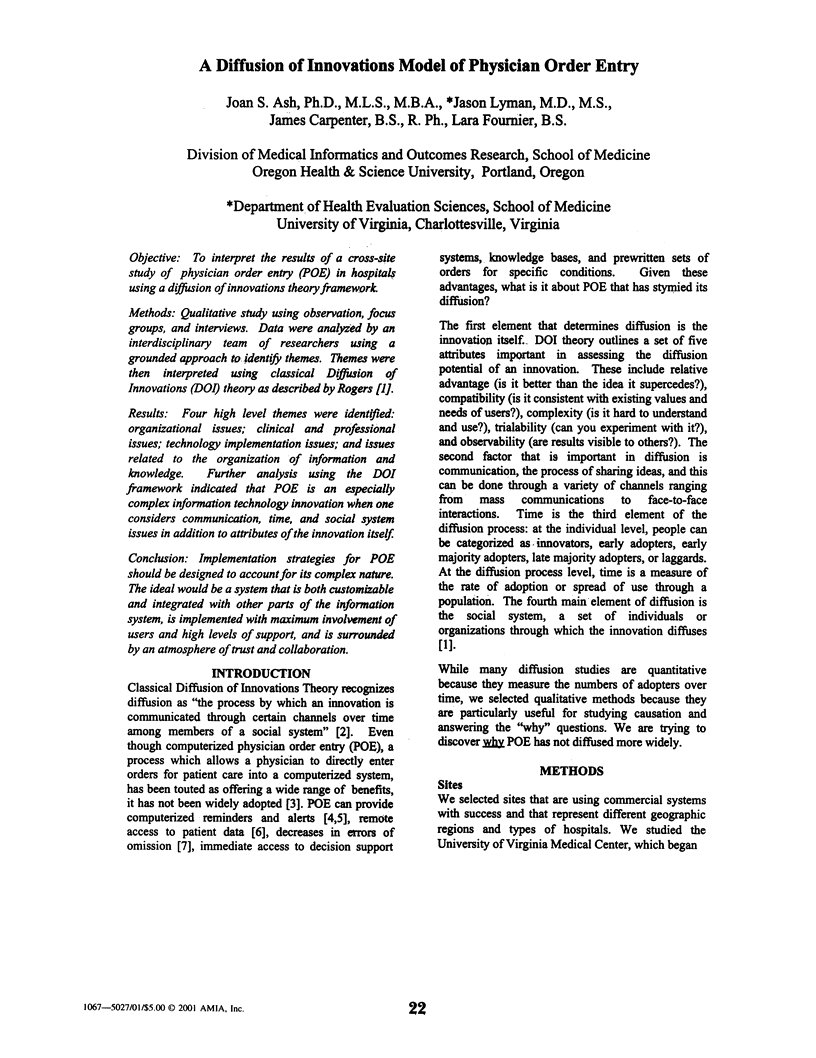Abstract
OBJECTIVE: To interpret the results of a cross-site study of physician order entry (POE) in hospitals using a diffusion of innovations theory framework. METHODS: Qualitative study using observation, focus groups, and interviews. Data were analyzed by an interdisciplinary team of researchers using a grounded approach to identify themes. Themes were then interpreted using classical Diffusion of Innovations (DOI) theory as described by Rogers [1]. RESULTS: Four high level themes were identified: organizational issues; clinical and professional issues; technology implementation issues; and issues related to the organization of information and knowledge. Further analysis using the DOI framework indicated that POE is an especially complex information technology innovation when one considers communication, time, and social system issues in addition to attributes of the innovation itself. CONCLUSION: Implementation strategies for POE should be designed to account for its complex nature. The ideal would be a system that is both customizable and integrated with other parts of the information system, is implemented with maximum involvement of users and high levels of support, and is surrounded by an atmosphere of trust and collaboration.
Full text
PDF




Selected References
These references are in PubMed. This may not be the complete list of references from this article.
- Ash J. S., Gorman P. N., Hersh W. R., Lavelle M., Poulsen S. B. Perceptions of house officers who use physician order entry. Proc AMIA Symp. 1999:471–475. [PMC free article] [PubMed] [Google Scholar]
- Ash J. S., Gorman P. N., Hersh W. R. Physician order entry in U.S. hospitals. Proc AMIA Symp. 1998:235–239. [PMC free article] [PubMed] [Google Scholar]
- Bates D. W. Frequency, consequences and prevention of adverse drug events. J Qual Clin Pract. 1999 Mar;19(1):13–17. doi: 10.1046/j.1440-1762.1999.00285.x. [DOI] [PubMed] [Google Scholar]
- Lee F., Teich J. M., Spurr C. D., Bates D. W. Implementation of physician order entry: user satisfaction and self-reported usage patterns. J Am Med Inform Assoc. 1996 Jan-Feb;3(1):42–55. doi: 10.1136/jamia.1996.96342648. [DOI] [PMC free article] [PubMed] [Google Scholar]
- McDonald C. J. The barriers to electronic medical record systems and how to overcome them. J Am Med Inform Assoc. 1997 May-Jun;4(3):213–221. doi: 10.1136/jamia.1997.0040213. [DOI] [PMC free article] [PubMed] [Google Scholar]
- Overhage J. M., Tierney W. M., Zhou X. H., McDonald C. J. A randomized trial of "corollary orders" to prevent errors of omission. J Am Med Inform Assoc. 1997 Sep-Oct;4(5):364–375. doi: 10.1136/jamia.1997.0040364. [DOI] [PMC free article] [PubMed] [Google Scholar]
- Rind D. M., Safran C., Phillips R. S., Wang Q., Calkins D. R., Delbanco T. L., Bleich H. L., Slack W. V. Effect of computer-based alerts on the treatment and outcomes of hospitalized patients. Arch Intern Med. 1994 Jul 11;154(13):1511–1517. [PubMed] [Google Scholar]


